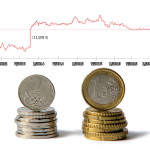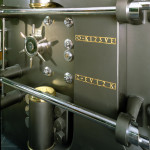Everyone awaits the decision of the National Bank, oriented this year towards stopping the devaluation interventions of the national currency. What will be the consequences?
It is one of the most debated issues in the financial sector, and not only there. The term of the intervention system on the circulation, thanks to which the Czech National Bank prevents the exchange to fall under the threshold of 27 crowns per euro, is approaching: the central bank has confirmed it wants to interrupt the intervention between April and June 2017. What will be the consequences?
Preventing speculative bubbles
The conclusion of the intervention regime on the crown has repeatedly been postponed in the past three and a half years. A first term was expected at the end of 2015, then postponed to the first half and then the end of 2016. Despite all these delays, the deadline of 2017 seems quite likely. The conditions, established by the Czech National Bank for the end of the interventions, seem to be agreed, i.e. the return of inflation growth of around two percent per annum. In the last months of 2016, inflation has taken a rigorous growth due to external stimuli, such as growth in the prices of fuel and raw materials, and internal stimuli such as rising prices for services and food. Moreover, the Czech Republic is not the only country to face a return of inflation dynamics: Germany, for example, is experiencing inflation close to 1.7 per cent per annum.
Another relevant factor is the cost of the intervention system. As evidenced by the central bank statistics, from November 2013 to November 2016, the institute has had to make Euro purchases of around 812 billion crowns to keep the exchange rate above the threshold. The intensity of the interventions on the market has been growing in recent months. “According to our estimates during January the central bank has had to purchase about 13 billion euro”, said the economist of Komerční banka, Viktor Zeisel. Unsurprisingly, even the Czech National Bank seems more determined to conclude the arrangements within the course, and not before the second quarter of this year. “We’re heading towards finally seeing the conditions met through a robust achievement of the target inflation”, the governor of the Czech National Bank Jiří Rusnok was keen to stress.
 What counts in the final decision of the central bank is also the behavior of the businesses and banks. Virtually all lending institutions make it known that there is an increase in the volume and the prices of contracts for the insurance exchange signed by the exporting companies. “So far it has been the Central Bank acting as our insurance exchange determining the instability of the price of the crown now at a record low, but the climate is changing”, said the president of the Association of Exporters Jiří Grund. The goal is to avoid as much shock in the currency markets like the one that occurred in January 2015, when the Swiss central bank surprisingly announced their will to abandon the fixed exchange rate with the euro, the so-called ‘peg’. Thanks to the surprise effect there was a drastic strengthening of the Swiss currency. “The Czech National Bank, on the other hand, has a tradition of great transparency of its decisions”, says the deputy governor Mojmír Hampl while emphasizing how continuous communication lowers the chances of a similar shock to that suffered by the Swiss franc.
What counts in the final decision of the central bank is also the behavior of the businesses and banks. Virtually all lending institutions make it known that there is an increase in the volume and the prices of contracts for the insurance exchange signed by the exporting companies. “So far it has been the Central Bank acting as our insurance exchange determining the instability of the price of the crown now at a record low, but the climate is changing”, said the president of the Association of Exporters Jiří Grund. The goal is to avoid as much shock in the currency markets like the one that occurred in January 2015, when the Swiss central bank surprisingly announced their will to abandon the fixed exchange rate with the euro, the so-called ‘peg’. Thanks to the surprise effect there was a drastic strengthening of the Swiss currency. “The Czech National Bank, on the other hand, has a tradition of great transparency of its decisions”, says the deputy governor Mojmír Hampl while emphasizing how continuous communication lowers the chances of a similar shock to that suffered by the Swiss franc.
Calm exporters, waiting importers
The partial devaluation of the Czech crown has had a significant impact on the foreign trade of the country. “If the course of the crown had remained at 25.747 crowns per euro, such as before the intervention, exporters would lose about 610 billion crowns”, says the vice president of the Association of Exporters Otto Daněk, according to whom the failure to strengthen the crown due to economic growth has been a benefit for Czech companies of another 280 billion crowns. According to several analysts and politicians, including President Miloš Zeman, however, the devaluation has lowered the drive for innovation and increased added value of the Czech productions, revealing a factor which led to the sluggishness of the national economy and thus to a deterioration in the competitiveness of companies.
In fact, according to the Czech Statistical Office data, the growth of value added in the manufacturing sectors has roughly followed the growth of the volume of production of the GDP. At the same time in 2014 and in 2015, the number of patents and licenses given by Czech companies increased. It should however be emphasized that the number of companies, who manage to sell the license for use of a patent, is barely forty. Similarly, only a tenth of the patents valid in the Czech Republic comes from Czech subjects. In light of these facts, it can be said that the devaluation has not made the innovative ability of Czech industry lazier, although it does nevertheless remain fairly low.
Although exporters are traditionally in favour of the weaker crown, the end of the intervention does not seem to worry them too much. According to their forecasts in the first half of the year exports are expected to grow by eight percent a year, thanks mainly to the expectation of recovery of the eurozone economies and a strong dynamic expansion of Germany. “But for the second half of the year the expectations are not so rosy. The main reason is the lack of the workforce, which significantly lowers the forecasts”, says the vice president Daněk. According to business associations, due to the lack of workers, in 2016 companies have had to give up to orders for 150 billion crowns.
The proposed strengthening of the crown could reinvigorate the internal market. The devaluation has made the imports from the eurozone more expensive. However, the recovery and the increased spending power of Czechs have largely compensated for this difficulty. For example, in the three years of the devaluation of the crown, imports of cars rose by 23.5 percent, clothing and footwear imports by more than twenty percent and household electrical appliances by 19.8 percent. Also the impact on tourism abroad seem contained. In 2014, a significant drop in foreign travel was registered, but the sector picked up in 2015. Last year, however, the number of summer trips abroad fell by about ten percent, while overnight stays in Czech hotels from domestic tourists grew by eight percent. “What strongly influenced the data, however, was the lack of safety they sensed in many of the favorite foreign destinations”, stressed the Association of Czech Travel Agencies.
But in the end will the Crown get stronger?
A slight strengthening of the crown will therefore have a positive impact on the internal market but it will combine with other factors, such as wage increases, thus not proving to be predominant. Also because the extent of the strengthening remains somewhat uncertain. According to the Association of exporters the exchange ratio could return to the same level as the previous one at the intervention of the central bank. Even official estimates of the Czech National Bank predict a strengthening. “But our forecasts do not take into account the fact that the reinforcement can be slowed by insurance on the exchange rate stipulated by the exporters and the closure of positions of financial investors. The effects of these purchases could even lead to a devaluation of the crown after the conclusion of the intervention on the circulation”, says the governor Rusnok. The Czech National Bank remains ready to intervene, should there be excessive swings in one direction or another.
by Jakub Horňáček








